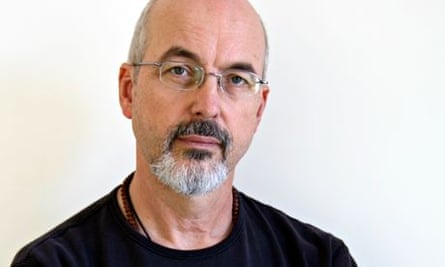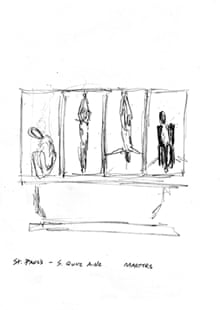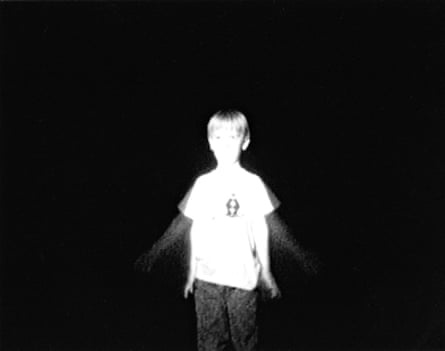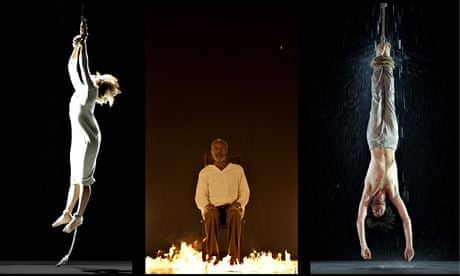Bill Viola was a freshman art student in 1970 when he first picked up a video camera. "As a very new piece of technology it was also very clunky and primitive," he recalls. "It was black and white and there was really little more to it than a red button that you pressed to record. But when I did press it, and I saw this blue glow on the screen before the actual image came up, something in my brain said I'd be doing this all my life. Of course, back then that was not a very realistic or practical idea. Video art was not a career option at the time. There was no job doing this. But it felt amazing to be in the forefront of this new thing that didn't have any rules and involved technological advance that hasn't stopped even today."
Video established itself relatively quickly in the art world (three of this year's four Turner prize-shortlisted artists use the form). However, its early reputation as an activity for a coterie of enthusiasts who produced work that tended towards the apparently obscure has somewhat lingered, although many of its technical and artistic advances have been seen by a mass audience in the form of pop videos and, more recently, computer games.
Against this backdrop Viola has emerged as one of the relatively few artists to break through to genuinely large mainstream audiences. He engages with the biggest themes of birth, death, suffering and transcendence. His slow-motion, super high-definition images – recently in conversation with old master paintings – have attracted large crowds all over the world. Viola's The Quintet of Remembrance, made in the aftermath of his father's death and exhibited at the Metropolitan Museum of Art in New York in the wake of 9/11, provided a focal point for a grieving city. In 2003, his The Passions was displayed in the National Gallery in London alongside some of the works that partly inspired it. Viola is currently the subject of a large retrospective at the Grand Palais in Paris, where blockbuster shows of Monet and Picasso have recently been held.
Not that everyone is convinced. One line of complaint can be boiled down to the assessment of a critic at the time of the National Gallery The Passions that Viola is "a master of overblown, big-budget, crowd-pleasing, tear-jerking hocus-pocus and religiosity". But, equally, he has been described as "the Rembrandt of the video age", and he makes no apology for wanting to be seen by a big audience. "For a time I would despise work that lots of people liked, but at some stage I realised that these things were not just for a small esoteric group. I really did want everyone to get at least something out of it."
His latest work, Martyrs, went on display at St Paul's Cathedral this week. The piece is billed as the first moving-image artwork to be installed in a British cathedral or church on a long-term basis and has been more than 10 years in the planning. "We had so many meetings and there have been many changes of personnel at the cathedral," he says. "But while the church works kind of slow, I also work kind of slow and pieces happen when they are ready." He was given two themes by the cathedral, Martyrs and Mary. "I think in images, and I scribbled the first thing that came out of my brain and it proved a good starting point," he says, producing a sketch of four panels (right), each containing a figure in some distress, which bears a striking resemblance to the finished work now sited behind the high altar and next to the chapel commemorating American casualties of the second world war.
The characteristically slow-moving figures of Martyrs are subjected to various elemental manifestations of earth, fire, air and water, and the Reverend Mark Oakley, canon chancellor of St Paul's, describes the work as a "spiritual offering to the cathedral. It is not an explicitly Christian work, but a Christian looking at it will find resonances. There is a man being crucified upside down, as St Peter was. St Peter lived a life on water as a fisherman. But we have hundreds of thousands of visitors every year, some are committed in their Christian faith, some are unsure, some are questioning, some are negative. And here is a piece of art that cuts across all of that and pierces through to the things that really matter. It leaves hovering the question, 'Is anything worth dying for?', and I can't think of a more important question at the moment. I see it through that Christian framework, but others will see it differently and that is the glory of art."
Standing in front of the screens, Viola says: "These people are left for dead and don't expect to live. That's all I'll say." His website describes his work as having roots in "both eastern and western art as well as spiritual traditions, including Zen Buddhism, Islamic Sufism, and Christian mysticism". Viola also travelled to northern India with his family to visit the Dalai Lama, but his work is not specifically religious, let alone Christian. "I guess I have been interested in the spiritual side of things since I was very young. But the form it took was me, in a very quiet way, simply looking with great focus at the ordinary things around me that I found wondrous. I still do today."

Viola was born in 1951 and brought up in and around New York City. While his wasn't an arty home – "it was more trips to the Natural History Museum than to art galleries" – he says his mother "had some ability and sort of taught me how to draw, so when I was three years old I could do pretty good motorboats and things like that". When Viola left school his father – a manager at Pan Am – insisted that he attend a university and not art school. "And in saying that he saved me," says Viola, who enrolled at Syracuse Arts Academy where he studied painting and electronic music before concentrating on video. "A lot of my friends were planning to go to art school and had I gone with them I would have been at least five years behind. The university had all the latest electronic equipment, as well as professors who were at the cutting edge of these new technologies. At art school I wouldn't have been able to wire up the whole campus or to work in a department of television."
It was as a student that he produced his first video works, most notably Tape I in 1972, which featured Viola in a mirror looking intently down the lens before delivering a blood-curdling cry and then obliterating the image by putting his finger into the tape spool. "It was a time of intense experimentation in all sorts of ways; technological and also in terms of looking at the self, and the video camera played into that. It was not just a matter of pointing it at something. It was about self-knowledge, and the camera could fracture the self. You realise there are two dimensions: what you see and what you feel, and that was a huge area to explore."
He says that conventional film-makers "thought we were idiots and that video would never last", but soon a community of video artists coalesced and, a couple of years later, "we started to get letters from England, France and Asia from people who were working out what this video camera thing could do. We realised that this thing was going on everywhere."
After graduating in 1973, Viola worked as a video technician in a Syracuse museum, studied with the modernist composer David Tudor, who had worked with John Cage, travelled to a ground-breaking video studio in Florence, before returning to New York to be the artist-in-residence at the WNET Channel 13 Television Laboratory. "And I had the good fortune to meet and work with established artists. I was an assistant to Nam June Paik who inspired me greatly – I learned a lot from him. Bruce Nauman was a hero of mine and I worked with Richard Serra."
By 1977, Viola's reputation was big enough to warrant an invitation to show his work in Australia from artistic director Kira Perov – "It helped that my father worked for Pan Am, so the travel was taken care of." They married a few years later, had two children and began to work increasingly closely together. Perov is now executive director of the Bill Viola Studio and an integral part of his work. "In the beginning it was really just me, with Kira doing what I said. But over time she has become like a midwife to the work, checking how the baby is doing, as well as handling all the practicalities of delivery." Viola works in a small study near their home in Long Beach, California. "I have my music and my tea, and I come up with ideas. When I think something is pretty good I will call her up, watch her cross the street and I know it will go one of two ways. Either the project will start, or she'll say 'Not ready' and I'll get cut down. Both of those responses are incredibly useful."

Viola's incorporation of his family into his work took another decisive turn following the death of his mother in 1991. He had shot some images of her as her life moved to a close, but had no intention of using them in his work. "And after she died I spent three months doing nothing. I was spiralling down and didn't even know if I wanted to be an artist any more. Up until then I'd strictly split my work and family life. All my home movies, which were becoming home videos by this time, were kept separate from my work videos. But when my mother died I realised I was an artist and I should do what I was set up to do, so I took all my home movies into the studio and I finished the next piece of work as if I was on fire and asked myself why I hadn't done this before."
Nantes Triptych, later bought by the Tate, featured images of his dying mother, a woman in labour and a man under water, and marked an intense emotional departure in his work, which he built upon with an increasing use of actors. "The early work had been all about me, as, although I didn't realise it at the time, I was probing myself in a medium that is exactly made for that. It takes you, flips you round and shows you yourself. But at a certain point I realised I was constantly hitting some sort of wall and I finally figured out that I should be on the other side of the camera. If I had kept doing just me it would have become more and more knotted and jumbled. I would be tripping over myself, but doing it this way, it became not about one person but about everybody."
Although he has had requests from Hollywood stars to appear in his work, he has kept to using less well-known faces, although sometimes ones with specific skills such as members of Cirque du Soleil, and says he is unlikely to go down the Steve McQueen route of a video artist moving into feature films. "I respect those people enormously and their movies are phenomenal. But I'm just not that interested in narrative. It always seemed old-fashioned to me and I wanted to do something a bit different in a new medium."
He says for most of his career he kept up with the breakneck speed of technological advance, but eventually learned that "I didn't have to run with the new thing every single time. For a time the new things helped me, the slow-motion button was invented at just the right time for me, but the work is not dependent on new equipment." Another apparent backwards step came with his embracing of the old masters, artists he had "hated" when a student. "My appreciation of older art had started to grow before my mother passed away, and when my father died at the end of the 90s I felt helpless and was looking for consolation. Although I'd never gone that way before, at that moment it was the most logical thing to do. I had been travelling in this forward direction and so I abruptly turned around and started going the other way. The Passion series was me coming to grips with the loss of my parents and being awakened as to what death really means. And therefore what existence really means. It's not a game, it's the deepest thing possible for a human being to conquer and try and understand, and I wanted to deal with that."

Martyrs will be joined by Mary in St Paul's next year, with both pieces owned by the Tate but on permanent loan to the cathedral. Martyrs is displayed on a stand specially designed by Norman Foster – "the church wouldn't allow us to put any more holes in the walls, so it sort of hangs in the air in a way that is very delicate and beautiful" – and on the other side of the Foster-designed bridge that runs across the Thames from near St Paul's to Tate Modern, Viola's 1993 work Tiny Deaths, his triple projected study of contrastingly lit figures, is currently on show. "I can't say when I was starting out that I could have imagined having work in both the Tate and St Paul's Cathedral," he laughs. "But there was this sense back then of all these big green pastures filled with different things: painting and sculpture, film, photography. And then we came along with our videos, which everyone else thought were toys, and we found a pasture that didn't have a lock on the gate and we just walked in. It was empty as far as the eye could see and you could stay for as long as you liked and do whatever you liked. That was our new field, and that was my career."

Comments (…)
Sign in or create your Guardian account to join the discussion